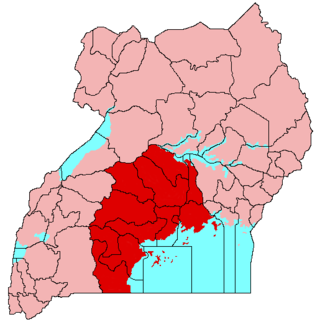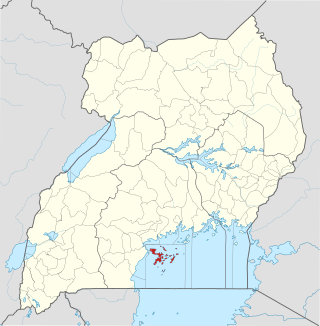
The Adhola people, also known as Jopadhola, are a Nilotic ethnic group of Luo peoples that live in Tororo District of Eastern Uganda and comprise about eight percent of the country's total population. They speak Dhopadhola,, which belongs to the Western Nilotic branch of the Nilotic language family. They are primarily pastoralists. The Jopadhola call their land Padhola which, according to historian Bethwell Ogot, is an elliptic form of “Pa Adhola” meaning the "place of Adhola", the founding father of the Jopadhola people. Officially, land of the Adhola is called Padhola, but the Baganda who misinterpret 'Widoma' – a Dhopadhola word for 'war cry' meaning 'You are in trouble' refer to the Jopadhola as "Badama". The social structure of the Jopadhola can be described as semi centralised because there is no traditional centralized government and its organization is limited to a clan called Nono. There are over 52 clans, each with cultural practices, common ancestry and a distinct lineage.

Buganda is a Bantu kingdom within Uganda. The kingdom of the Baganda people, Buganda is the largest of the traditional kingdoms in present-day East Africa, consisting of Buganda's Central Region, including the Ugandan capital Kampala. The 14 million Baganda make up the largest Ugandan region, representing approximately 16% of Uganda's population.

The Ssese Islands are an archipelago of eighty-four islands in the northwestern part of Lake Nalubaale in Uganda. The islands are coterminous with the Kalangala District in southern Central Uganda, which does not have any territory on mainland Uganda.

Masaka District is a district in Buganda Kingdom in Uganda. Its main town is Masaka City, whose estimated population in 2011 was 74,100.

Kalangala, also known as Ssesse, is a district in Central Uganda. The district is coterminous with the Ssese Islands in Lake Victoria and does not have territory on mainland Uganda. Like other Ugandan districts, it is named after its 'chief town', Kalangala which is located on Bugala Island, the largest of the Ssese Islands.

Mukono is one of the districts in the Central Region of Uganda. The town of Mukono is home to the district's main commercial center and district headquarters.

Wakiso District is a district in the Central Region of Uganda that partly encircles Kampala, Uganda's capital city. The town of Wakiso is the site of the district headquarters. Kira, the country's second largest city and suburb of Kampala, is in the district.

Busoga is a kingdom and one of four constitutional monarchies in present-day Uganda. The kingdom is a cultural institution which promotes popular participation and unity among the people of the region through development programs to improve their standard of living.

Kalangala is a town in Kalangala District in the Central Region of Uganda. It is the headquarters of the district.

There are two major sources of fish in Uganda; one is from aquaculture, the other from fishing in rivers and lakes. The latter has made up the largest and most significant share of all fishing. Open water covers 15.3 percent of Uganda's surface and comprises five major lakes which are the main sources of fish in the country. Lake Victoria continues to be the most important water body in Uganda both in size and contribution to the total fish catch, followed by Lake Albert and Lake Kyoga.
Bugala Power Station is a 1.5 megawatts (2,000 hp) biodiesel-fired thermal power plant located on Bugala Island, in Kalangala District, in the Ssese Islands Archipelago, on Lake Victoria, in south-central Uganda.

The Kasubi Tombs in Kampala, Uganda, is the site of the burial grounds for four kabakas and other members of the Baganda royal family. As a result, the site remains an important spiritual and political site for the Ganda people, as well as an important example of traditional architecture. It became a UNESCO World Heritage Site in December 2001, when it was described as "one of the most remarkable buildings using purely vegetal materials in the entire region of sub-Saharan Africa".

The Baganda also called Waganda, are a Bantu ethnic group native to Buganda, a subnational kingdom within Uganda. Traditionally composed of 52 clans, the Baganda are the largest people of the Bantu ethnic group in Uganda, comprising 16.5 percent of the population at the time of the 2014 census.

Koome is an island in Lake Victoria, Uganda.
Kibulala, Ssingo, commonly known as Kibulala, is a hill in Ssingo County, Kiboga District in Central Uganda. The hill rises approximately 1,250 metres (4,100 ft) above sea level. The name also applied to the village that sits on top of the hill and the Buganda cultural site located there.
Bukuzindu Hybrid Solar and Thermal Power Station is a 1.6MW hybrid solar and diesel fuel-fired thermal power plant in Uganda, the third-largest economy in the East African Community.
Fishing sites and villages/communities in Uganda are mostly on islands and at landing sites. These act as central points for fish trade and fishing.
Nvumetta Ruth Kavuma better known as Ruth Kavuma is a Ugandan politician, rotarian and educator. She was the first African headmistress of Gayaza High School for 11 years between 1990 and 2002. After leaving Gayaza High School, she joined politics and became the woman Member of Parliament in the eighth Parliament of Uganda representing Kalangala District under the National Resistance Movement political party. She is a founding members of Forum for African Women Educationalists (FAWE) and became the first Chairperson of Board of the Uganda Chapter, an organization that advocates for girl child education.
Lutoboka Central Forest Reserve is a protected area in Uganda's Eastern district of Kalangala. The 174 hectares Lutoboka Forest Reserve is located in Kalangala Town Council on Bugala Island.
Luggo Forest also known as LuggoCulturalForest is an heritage site and tourism Centre and home to many tree species in the Bujumba subcounty of Uganda's Kalangala district. It is a private forest found in Buswa Village along Kalangala -Mulabana Road surrounded by oil palm plantations. It is the only forest containing the tree where the mace (Ddamula) symbolizing the authority of the Katikkiro is cut from. The mace commonly known as "Ddamula" was handed over by the Kabaka to the Katikkiro symbolizing the transfer of authority to the Katikkiro to rule over Buganda on his behalf.

















